
12: Drummers Drumming (in the right chairs)
 On top of high levels of concentration, musical performance places significant physical stress on the body. Strength in limb muscles needed for fast complex movements, while core muscles handle the task of sustaining body position for extended durations.
On top of high levels of concentration, musical performance places significant physical stress on the body. Strength in limb muscles needed for fast complex movements, while core muscles handle the task of sustaining body position for extended durations.
It is therefore no wonder that musical performance-associated musculoskeletal disorders (MSD) are a common medical issue among professional musicians, with some studies indicating that around 80% – 97% of orchestral musicians suffer from muscle pain related to musical performance.
With MSDs presenting such a big threat to musicians’ professional activity, avoiding causes like faults in upper body posture are highly important. A methodology published in the Journal of Occupational Medicine and Toxicology suggests a way of analyzing the instrument specific posture and pressure distribution during seating to give musicians an indication of the right music chair to use.
11: Pipefish piping

Closely related to seahorses and seadragons, pipefish belong to the fish family Syngnathidae which date back around 50 million years. The species in this family possess a host of unusual features: elongated snouts for suction like feeding, bony armor, and brood pouches on males. These unique body plans make them fascinating models for researchers exploring how these features develop.
In a huge step forward in this research area, scientists at the University of Oregon have produced a detailed genome of the gulf pipefish Syngnathus scovelli which is abundant to seagrass beds in the Gulf of Mexico. This delivers a new reference tool for scientists to explore the peculiar Syngnathidae family and opens a window to the genomics underpinning their unique morphologies.
10: Jerboas leaping
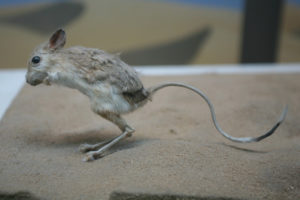
You probably wouldn’t know a jerboa if it hopped right in front of you; but these desert dwelling rodents, that somewhat resemble miniature kangaroos or a Tyrannosaurus imagined as a mouse, have some seriously impressive morphological adaptations.
With elongated hindlimbs these small bipedal mammals, native to North Africa and Eurasia, use an erratic form of locomotion that involves constantly switching between hopping, running, turning, and vertically leaping several feet in order to avoid predation.
By observing Lesser Egyptian jerboa Jaculus jaculus locomotion in a laboratory setting, researchers at Harvard University found that unlike the morphologically similar kangaroo rat, which uses tendon elastic energy to leap, Jerboas produce most of the energy when vertical leaping from muscles acting at the ankle joint.
The large contribution from muscles rather than elastic energy suggests rapid acceleration away from predators was of greater benefit to jerboas in their evolutionary history than conserving energy through elastic energy storage for sustained hopping.
9: Employees dancing

‘Learning a new dance move everyday’ probably won’t feature as a target in your workplace annual review, but this is exactly what researchers at the Curtin University, Australia are proposing in a study registered in the ISRCTN registry this year.
The researchers are examining the effects of a program to increase the movement of office workers throughout the day. The program involves learning a new dance movement from a video link each day, gradually building to that week’s choreography. It’s hoped that this will improve the physical and mental well-being of the participating staff.
8: Maids a-milking (buffaloes)
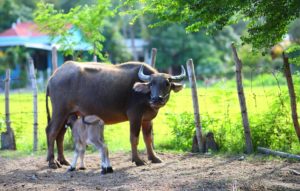
In your average supermarket you might be hard pressed to find a carton of buffalo milk, despite the health advantages it appears to have over cow milk: containing lower concentrations of cholesterol and higher amounts of unsaturated fatty acids and protein. Buffalo milk is actually preferred to cow milk in India and Pakistan, thanks to these health benefits and a creamier taste. These countries collectively contribute 80% of world’s produce.
Now research published in Lipids in Health and Disease adds further support to the health benefits of buffalo milk. Researchers in the study exposed both cow and buffalo milk to two heat treatments and examined the composition of the milks when they were pasteurized, boiled or untreated. They found the buffalo milk to have a much higher antioxidant capacity than cow milk, regardless of whether it was treated or not.
7: Athena SWAN a-chartering
 The Athena SWAN Charter is an intervention that aims to advance gender equality in STEMM through encouraging and recognizing commitments towards this goal. The Charter has expanded over the years to cover people in academic roles both in STEMM and AHSSBL, support staff, and students and supports their representation, career development and working environment.
The Athena SWAN Charter is an intervention that aims to advance gender equality in STEMM through encouraging and recognizing commitments towards this goal. The Charter has expanded over the years to cover people in academic roles both in STEMM and AHSSBL, support staff, and students and supports their representation, career development and working environment.
In order to measure the impact of ATHENA SWAN and explore people’s perceptions and experiences of it, researchers at the University of Oxford used survey data from two research projects measuring dimensions of organizational culture and the experiences of women in science at the university.
The findings suggested that although there were concerns over Athena SWAN having limited ability to address entrenched power and pay imbalances as well as questions over the sustainability of change, Athena SWAN was seen to be making a positive impact: with both women and men reporting that participation in the charter had been fundamental in structural and cultural changes. These included challenging discrimination and increased support for women’s careers.
If you’d like to hear more about this study you can read a Q&A with the lead researcher here.
6: Psychopaths a-lying

A trait that many would associate with psychopathic behavior is the ability to easily lie; psychopathy is even characterized by untruthfulness and manipulativeness. These traits are often the hallmarks of fictionalized psychopaths.
Whilst it remains unclear whether high-psychopathic individuals lie more or better than others, research published in Translational Psychiatry found that individuals with high levels of psychopathic traits were better at learning to lie.
The study involved students, recruited for having either high or low levels of psychopathic traits, being shown a series of photographs featuring familiar or unfamiliar faces and then giving honest or dishonest responses when asked whether they knew the person. After two training sessions, the students with high levels of psychopathic traits were able to lie significantly quicker; whereas those with low levels of psychopathic traits showed no improvement.
The findings indicate that while people with psychopathic traits may not have a natural ability to lie better; they may be better at learning to lie.
5: Gold nanoparticles
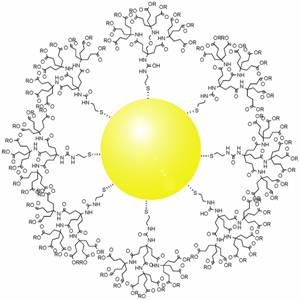 Nanotechnology is being applied across the medical industry as a promising way to develop drugs and devises with improved safety, quality and performance. Although some nanoparticles are designed to degrade in the body, durable nanoparticles made of materials like gold are designed to remain in particulate state beyond administration. This longevity raises questions over the long term effects of these particles in the body.
Nanotechnology is being applied across the medical industry as a promising way to develop drugs and devises with improved safety, quality and performance. Although some nanoparticles are designed to degrade in the body, durable nanoparticles made of materials like gold are designed to remain in particulate state beyond administration. This longevity raises questions over the long term effects of these particles in the body.
In a research article published in Particle and Fibre Toxicology, researchers tested the effects of gold, silver and silica nanoparticles in mice over 8 weeks. They found that after repeated dosing, none of the three nanoparticles led to saturated bio-accumulation in liver and no toxicity was observed with gold and silver nanoparticles.
4: Calling cuckoos
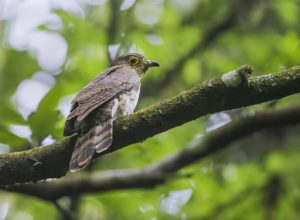 For many in the Northern hemisphere, hearing the charismatic ‘cu-coo’ call of the common cuckoo marks the arrival of spring. However, for a family of birds that play the role of host and unsuspecting surrogate parent to the parasitic cuckoos’ offspring, this sound marks imminent fitness loss.
For many in the Northern hemisphere, hearing the charismatic ‘cu-coo’ call of the common cuckoo marks the arrival of spring. However, for a family of birds that play the role of host and unsuspecting surrogate parent to the parasitic cuckoos’ offspring, this sound marks imminent fitness loss.
This example of avian brood parasitism has been studied for centuries and demonstrates an evolutionary arms race between the host and the parasite. This arms race has profound effects on the species involved, leading to egg mimicry and reduced female body size of the cuckoo. It’s thought that brood parasitism could be associated with vocal evolution in parasitic species like the cuckoo, with the parasite varying it’s vocalizations to mimic the hosts song.
A research article published in Avian Research looked at male calls in species belonging to the subfamily Cuculinae, comparing parasitic and non-parasitic species in order to explore the evolutionary patterns of vocalization. The researchers found that the vocal structures of the parasitic species tended to be simple with low-frequency calls and fewer harmonic structures, indicating that brood parasitic behavior plays a role in vocal evolution.
3: Pecking hens
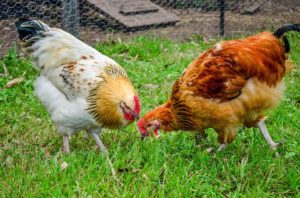 In egg laying hens, feather pecking and aggressive pecking behaviors cause serious welfare and economic issues. Why hens perform these behaviors is unknown, despite extensive research over the last decade.
In egg laying hens, feather pecking and aggressive pecking behaviors cause serious welfare and economic issues. Why hens perform these behaviors is unknown, despite extensive research over the last decade.
Utilizing data from their previous research, a group from the University of Hohenheim has now genotyped hens that displayed feather pecking and aggressive pecking behaviors. They found numerous single-nucleotide polymorphisms in clusters that were significantly differently expressed in the brains of hens displaying these behaviors. The researchers conclude that these behavioral traits were controlled by many genes, each contributing small effects. The mystery behind these problematic behaviors, for the time being, remains unsolved.
2: Turtle droves
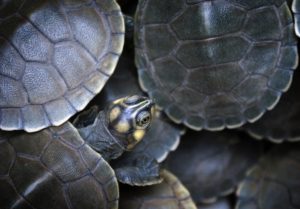 In August we announced the winners of our annual BMC Ecology image competition. Winners were chosen across a diverse range of categories such as: Behavioral and Physiological Ecology, Community, Population and Macroecology and Conservation Ecology and Biodiversity.
In August we announced the winners of our annual BMC Ecology image competition. Winners were chosen across a diverse range of categories such as: Behavioral and Physiological Ecology, Community, Population and Macroecology and Conservation Ecology and Biodiversity.
The overall winner for competition was awarded to Ana Carolina Lima for her image of a group of giant South American turtles. Taken in the tartaruga-da-amazônia in the Cantão State Park, Brazil, the photograph shows a group of juvenile turtles being weighed and measured. When fully grown they will reach almost 110cm in shell length and weigh up to 90kg.
And an aphid in a peach tree
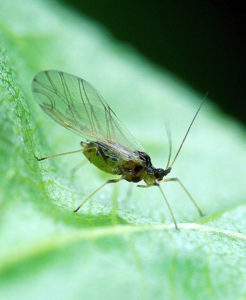 Insect herbivores tend feed on a small number of closely related plant species, locked in an evolutionary arms race against their host plant. In contrast to this the green peach aphid Myzus persicae has colonized over 400 hundred plant species, making it an incredibly successful pest.
Insect herbivores tend feed on a small number of closely related plant species, locked in an evolutionary arms race against their host plant. In contrast to this the green peach aphid Myzus persicae has colonized over 400 hundred plant species, making it an incredibly successful pest.
Green peach aphids spend winters on host plants such as peach trees but in summer months they can colonize a wide range of crops such as potatoes, spinach and parsley.
In order to explore this phenotypic plasticity, researchers sequenced the green peach aphid genome. Aphids are able to reproduce by making clones of themselves and interestingly the researchers found that even aphids that are genetically identical were able colonize distantly related plant species. This is achieved through the up and down regulation of genes found in clusters. Within two days of the aphid switching host, these clusters were rapidly up or down regulated, allowing the aphid to colonize the new host plant.
Comments